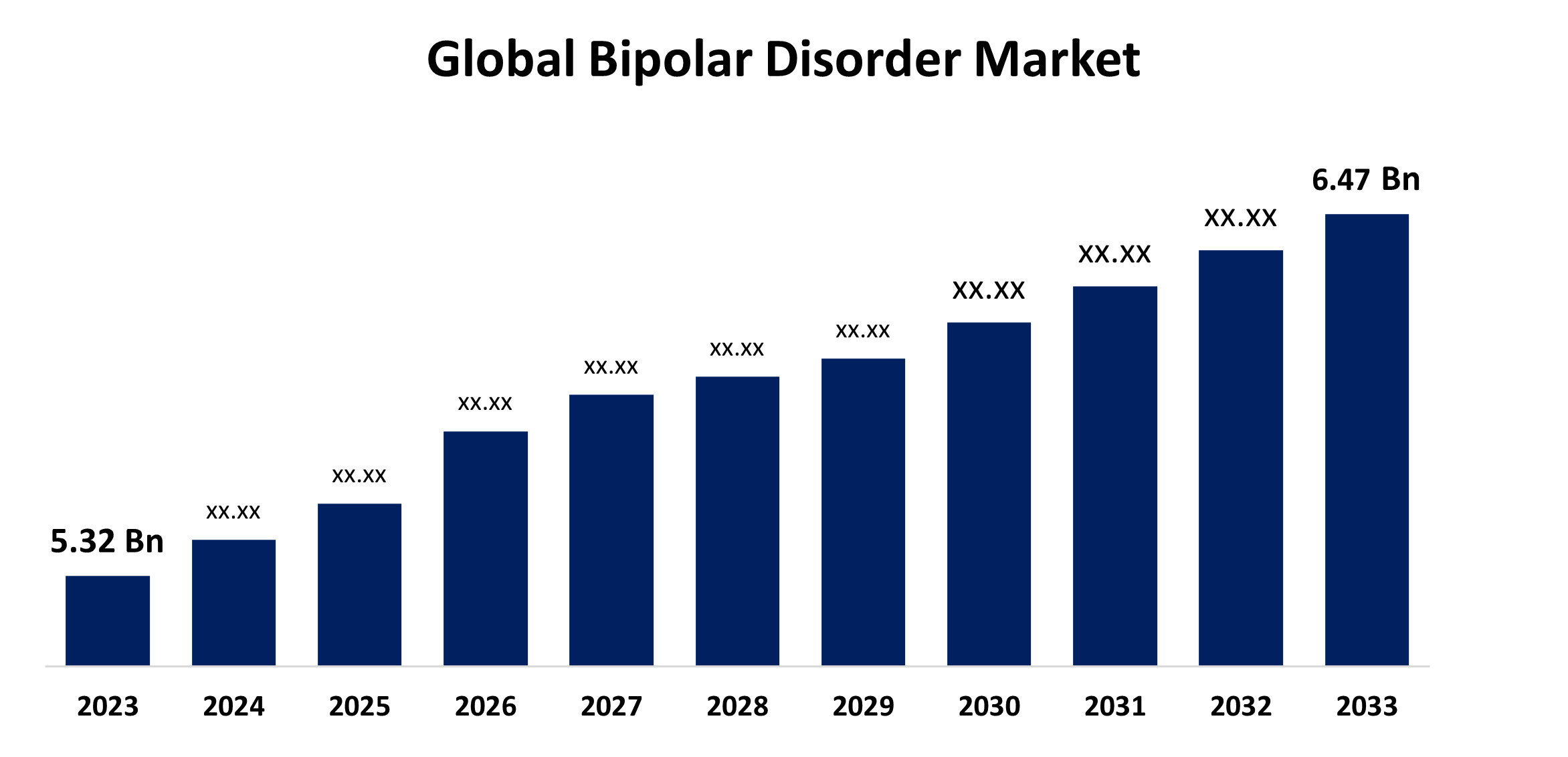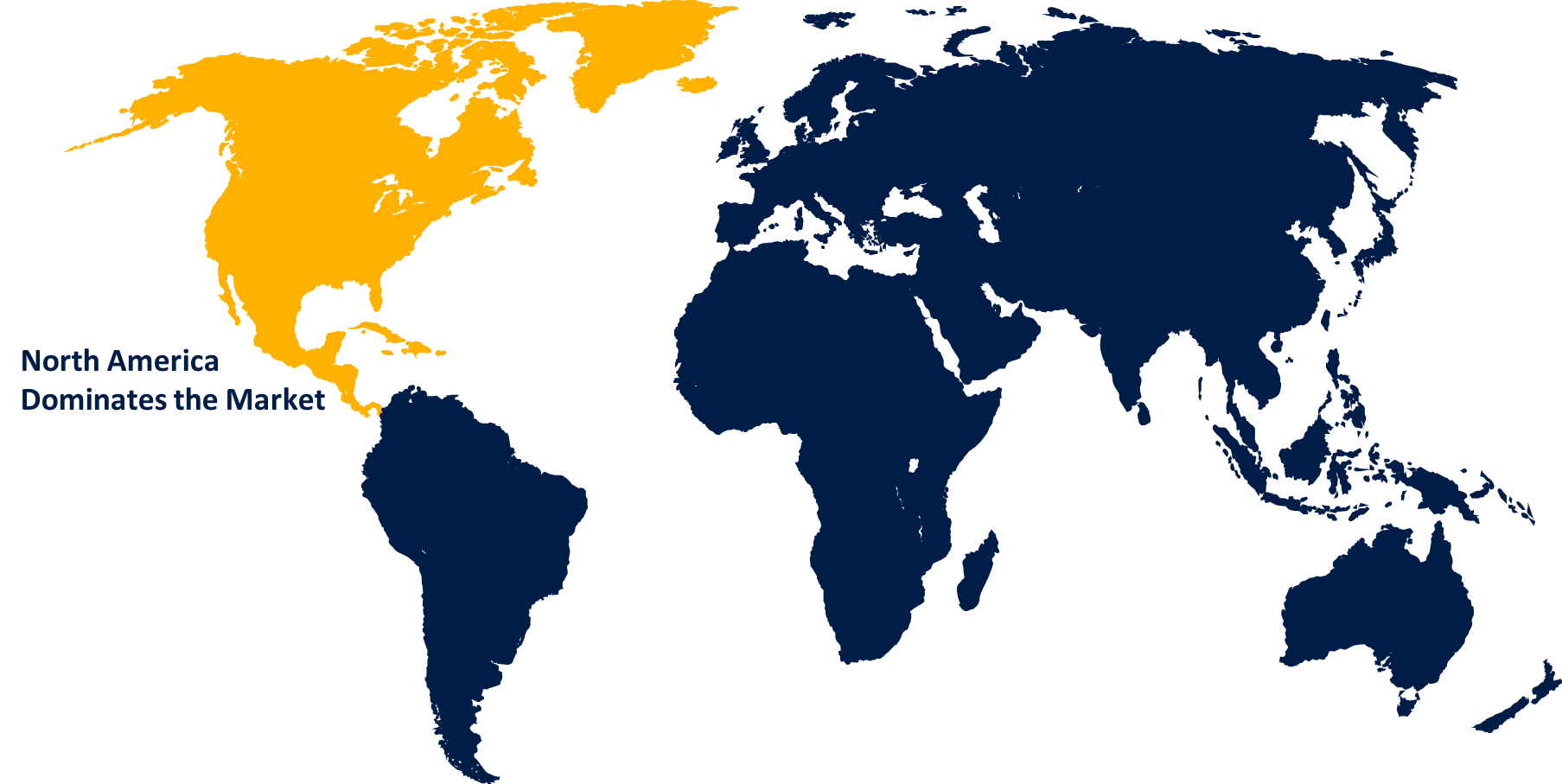Global Bipolar Disorder Market Size, Share, and COVID-19 Impact Analysis, By Type (Bipolar I Disorder, Bipolar II Disorder, Cyclothymic Disorder, Others), By Drug Class (Mood Stabilizers, Anticonvulsants, Antipsychotic Drugs, Antidepressant Drugs), and By Region (North America, Europe, Asia-Pacific, Latin America, Middle East, and Africa), Analysis and Forecast 2023 - 2033
Industry: HealthcareGlobal Bipolar Disorder Market Insights Forecasts to 2033
- The Global Bipolar Disorder Market Size was Valued at USD 5.32 Billion in 2023
- The Market Size is Growing at a CAGR of 1.98% from 2023 to 2033
- The Worldwide Bipolar Disorder Market Size is Expected to Reach USD 6.47 Billion by 2033
- Asia Pacific is Expected to Grow the fastest during the forecast period.

Get more details on this report -
The Global Bipolar Disorder Market Size is Anticipated to Exceed USD 6.47 Billion by 2033, Growing at a CAGR of 1.98% from 2023 to 2033.
Market Overview
Bipolar disorder is an emotional disorder which can be chronic (permanent or recurring) or episodic (occurring irregularly). Bipolar disorder can also be referred to using the older labels "manic-depressive disorder" or "manic depression." Bipolar disorder symptoms develop in late childhood or early adulthood. Children can occasionally show symptoms of bipolar disorder. While symptoms can fluctuate, bipolar disorder often requires lifelong therapy and does not resolve on its own. Bipolar disorder can contribute to suicide, job loss, impaired functioning, and family conflict. However, good therapy can lead to better functioning and a higher quality of life. For Instance, in April 2024, Vanda Pharmaceuticals Inc. (Vanda) (Nasdaq: VNDA) announced that the U.S. Food and Drug Administration, or FDA, has approved Fanapt® (iloperidone) tablets for the immediate management of manic or mixed episodes in people with bipolar I disorder. Fanapt®, an atypical antipsychotic drug, has been utilized in the acute treatment of schizophrenia patients since its approval by the FDA in 2009. Several factors are driving the expansion of this market, including the increased prevalence of bipolar illness, government help in raising awareness about the condition, and technological advancements that allow for exact detection of a patient's mood and mental state. Thus, due to such factors, the market growth for the bipolar disorder market is fueling in the forecast period.
Report Coverage
This research report categorizes the market for the global bipolar disorder market based on various segments and regions forecasts revenue growth and analyzes trends in each submarket. The report analyses the key growth drivers, opportunities, and challenges influencing the global bipolar disorder market. Recent market developments and competitive strategies such as expansion, product launch, and development, partnership, merger, and acquisition have been included to draw the competitive landscape in the market. The report strategically identifies and profiles the key market players and analyses their core competencies in each sub-segment of the global bipolar disorder market.
Global Bipolar Disorder Market Report Coverage
| Report Coverage | Details |
|---|---|
| Base Year: | 2023 |
| Market Size in 2023 : | USD 5.32 Billion |
| Forecast Period: | 2023-2033 |
| Forecast Period CAGR 2023-2033 : | 1.98% |
| 2033 Value Projection: | USD 6.47 Billion |
| Historical Data for: | 2019-2022 |
| No. of Pages: | 207 |
| Tables, Charts & Figures: | 110 |
| Segments covered: | By Type, By Drug Class, By Region |
| Companies covered:: | Bristol Myers Squibb Company, Eli Lilly and Company, GlaxoSmithKline plc, H. Lundbeck A/S, Janssen Pharmaceuticals Inc., Otsuka Holdings Co. Ltd., Pfizer Inc., Sunovion Pharmaceuticals Inc., Teva Pharmaceutical Industries Ltd., Takeda Pharmaceutical Company Limited, Abbott Laboratories, Novartis International AG, Alkermes plc, AbbVie Inc., Merck & Co. Inc., Mylan N.V., Neurocrine Biosciences Inc., Vanda Pharmaceuticals Inc., and Key Others Key Vendors. |
| Pitfalls & Challenges: | COVID-19 Empact, Challenges, Future, Growth, & Analysis |
Get more details on this report -
Driving Factors
Technological advancements that enable more accurate detection of a patient's mood have a favorable impact on market growth. The government's bipolar disorder awareness efforts are also driving market expansion. The rising prevalence of bipolar illness and its associated hazards, such as high stress, substance misuse, and others, as well as advances in drug combinations and the need for antidepressant medications, are driving the global bipolar disorder market. Other factors projected to fuel market expansion include increased R&D efforts and government initiatives in the healthcare industry. Furthermore, growing public awareness regarding bipolar disease and enhanced technology that allows for exact detection of a patient's mood and mental condition will boost the growth of the bipolar disorder market.
Restraining Factors
The lack of useful diagnostic tools for disease diagnosis, as well as the adverse reactions of bipolar disorder treatments, are expected to limit market growth.
Market Segmentation
The global bipolar disorder market share is classified into type and drug class.
- The bipolar I disorder segment is expected to hold the largest share of the global bipolar disorder market during the forecast period.
Based on the type, the global bipolar disorder market is categorized into bipolar I disorder, bipolar II disorder, cyclothymic disorder, and others. Among these, the bipolar I disorder segment is expected to hold the largest share of the global bipolar disorder market during the forecast period. Bipolar I disorder type is a serious mental disorder that includes constant mood swings (manias), as well as (in most cases) episodes of depression and, in many cases, psychosis. The effects of BP-I are severe, encompassing both direct and indirect concerns. Suicide rates among BP-I patients are high and they have a lower quality of life and productivity than unaffected people. Bipolar disorder, particularly the most severe kind (type I), has a significant genetic component. Family studies indicate that this condition is caused by a few genes with a minor effect.
- The antipsychotic drugs segment is expected to grow at the fastest CAGR during the forecast period.
Based on the drug class, the global bipolar disorder market is categorized into mood stabilizers, anticonvulsants, antipsychotic drugs, and antidepressant drugs. Among these, the antipsychotic drugs segment is expected to grow at the fastest CAGR during the forecast period. The rising prevalence of depression caused by physical illness and psychosis. Antidepressants are drugs that treat serious depressive disorders, anxiety disorders, and chronic pain conditions.
Regional Segment Analysis of the Global Bipolar Disorder Market
- North America (U.S., Canada, Mexico)
- Europe (Germany, France, U.K., Italy, Spain, Rest of Europe)
- Asia-Pacific (China, Japan, India, Rest of APAC)
- South America (Brazil and the Rest of South America)
- The Middle East and Africa (UAE, South Africa, Rest of MEA)
North America is projected to hold the largest share of the global bipolar disorder market over the forecast period.

Get more details on this report -
North America is projected to hold the largest share of the global bipolar disorder market over the forecast period. The increasing prevalence of bipolar disorder in countries such as the United States and Canada. In addition, the presence of robust healthcare infrastructure facilities, as well as the rising prevalence of bipolar illnesses, would present attractive potential opportunities for the region's market over the projection period. According to the National Alliance on Mental Illness, roughly one out of every five adults in the United States suffers from a mental disorder each year, requiring hospitalization. All of these variables will drive regional industry expansion over the predicted period.
Asia Pacific is expected to grow at the fastest CAGR growth of the global bipolar disorder market during the forecast period. Mental diseases have recently become more common in APAC countries such as India and China. As a result, this factor will likely drive the bipolar disorder market in this area over the forecast period.
Competitive Analysis:
The report offers the appropriate analysis of the key organizations/companies involved within the global bipolar disorder market along with a comparative evaluation primarily based on their product offering, business overviews, geographic presence, enterprise strategies, segment market share, and SWOT analysis. The report also provides an elaborative analysis focusing on the current news and developments of the companies, which includes product development, innovations, joint ventures, partnerships, mergers & acquisitions, strategic alliances, and others. This allows for the evaluation of the overall competition within the market.
List of Key Companies
- Bristol Myers Squibb Company
- Eli Lilly and Company
- GlaxoSmithKline plc
- H. Lundbeck A/S
- Janssen Pharmaceuticals Inc.
- Otsuka Holdings Co. Ltd.
- Pfizer Inc.
- Sunovion Pharmaceuticals Inc.
- Teva Pharmaceutical Industries Ltd.
- Takeda Pharmaceutical Company Limited
- Abbott Laboratories
- Novartis International AG
- Alkermes plc
- AbbVie Inc.
- Merck & Co. Inc.
- Mylan N.V.
- Neurocrine Biosciences Inc.
- Vanda Pharmaceuticals Inc.
- Others
Key Market Developments
- On May 2024, NRx Pharmaceuticals, Inc., a clinical-stage pharmaceutical company, announced that NRX-101 had a statistically significant safety advantage over the standard of care comparator in a recently completed clinical trial in patients with suicidal bipolar depression.
- On February 2024, Baszucki Group has established another collaboration with McLean Hospital in Belmont, MA, to conduct a clinical investigation of a therapeutic ketogenic diet for bipolar disorder. A cross-disciplinary team from McLean's early psychosis programmer will look into nutritional ketosis as a new therapeutic method and a vital tool for studying the underlying mechanisms of bipolar disease.
Key Target Audience
- Market Players
- Investors
- End-users
- Government Authorities
- Consulting And Research Firm
- Venture capitalists
- Value-Added Resellers (VARs)
Market Segment
This study forecasts revenue at global, regional, and country levels from 2020 to 2033. Spherical Insights has segmented the global bipolar disorder market based on the below-mentioned segments:
Global Bipolar Disorder Market, By Type
- Bipolar I Disorder
- Bipolar II Disorder
- Cyclothymic Disorder
- Others
Global Bipolar Disorder Market, By Drug Class
- Mood Stabilizers
- Anticonvulsants
- Antipsychotic Drugs
- Antidepressant Drugs
Global Bipolar Disorder Market, By Regional
- North America
- US
- Canada
- Mexico
- Europe
- Germany
- UK
- France
- Italy
- Spain
- Russia
- Rest of Europe
- Asia Pacific
- China
- Japan
- India
- South Korea
- Australia
- Rest of Asia Pacific
- South America
- Brazil
- Argentina
- Rest of South America
- Middle East & Africa
- UAE
- Saudi Arabia
- Qatar
- South Africa
- Rest of the Middle East & Africa
Frequently Asked Questions (FAQ)
-
1.What is the CAGR of the global bipolar disorder market over the forecast period?The Global Bipolar Disorder Market Size is Expected to Grow from USD 5.32 Billion in 2023 to USD 6.47 Billion by 2033, at a CAGR of 1.98% during the forecast period 2023-2033.
-
2.Which region is expected to hold the highest share in the global bipolar disorder market?North America is projected to hold the largest share of the global bipolar disorder market over the forecast period.
-
3.Who are the top key players in the bipolar disorder market?Bristol Myers Squibb Company, Eli Lilly and Company, GlaxoSmithKline plc, H. Lundbeck A/S, Janssen Pharmaceuticals Inc., Otsuka Holdings Co. Ltd., Pfizer Inc., Sunovion Pharmaceuticals Inc., Teva Pharmaceutical Industries Ltd., Takeda Pharmaceutical Company Limited, Abbott Laboratories, Novartis International AG, Alkermes plc, AbbVie Inc., Merck & Co. Inc., Mylan N.V., Neurocrine Biosciences Inc., Vanda Pharmaceuticals Inc., and others.
Need help to buy this report?